
The Caravaggisti were stylistic followers of the late 16th-century Italian Baroque painter Caravaggio. His influence on the new Baroque style that eventually emerged from Mannerism was profound. Caravaggio never established a workshop as most other painters did, and thus had no school to spread his techniques. Nor did he ever set out his underlying philosophical approach to art, the psychological realism which can only be deduced from his surviving work. But it can be seen directly or indirectly in the work of Rubens, Jusepe de Ribera, Bernini, and Rembrandt. Famous while he lived, Caravaggio himself was forgotten almost immediately after his death. Many of his paintings were re-ascribed to his followers, such as The Taking of Christ, which was attributed to the Dutch painter Gerrit van Honthorst until 1990.

The Alte Pinakothek is an art museum located in the Kunstareal area in Munich, Germany. It is one of the oldest galleries in the world and houses a significant collection of Old Master paintings. The name Alte (Old) Pinakothek refers to the time period covered by the collection—from the fourteenth to the eighteenth century. The Neue Pinakothek, re-built in 1981, covers nineteenth-century art, and Pinakothek der Moderne, opened in 2002, exhibits modern art. All three galleries are part of the Bavarian State Painting Collections, an organization of the Free state of Bavaria.

The Galleria Nazionale d'Arte Antica or National Gallery of Ancient Art is an art museum in Rome, Italy. It is the principal national collection of older paintings in Rome – mostly from before 1800; it does not hold any antiquities. It has two sites: the Palazzo Barberini and the Palazzo Corsini.
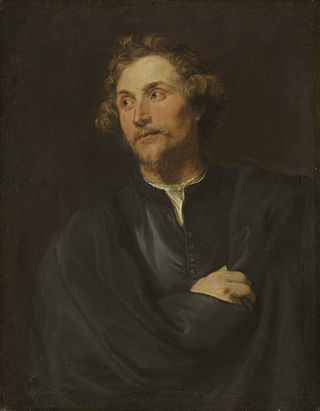
Georg Petel or Jorg Petel was a German sculptor and a virtuoso ivory carver. His work marks the beginning of Baroque sculpture in Germany.

Tobias Verhaecht (1561–1631) was a painter from Antwerp in the Duchy of Brabant who primarily painted landscapes. His style was indebted to the mannerist world landscape developed by artists like Joachim Patinir and Pieter Bruegel the Elder. He was the first teacher of Pieter Paul Rubens.
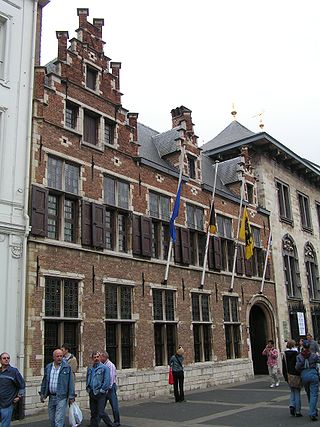
The Rubenshuis is the former home and workshop of Peter Paul Rubens (1577–1640) in Antwerp. Purchased in 1610, Rubens had the Flemish townhouse renovated and extended on the basis of designs by Rubens himself. After the renovations, the house and its courtyard garden had the outlook of an Italian palazzo, which reflected the artistic ideals of Rubens. The ensemble is now a museum dedicated mainly to the work of Rubens and his contemporaries.

Sir Peter Paul Rubens was a Flemish artist and diplomat. He is considered the most influential artist of the Flemish Baroque tradition. Rubens' highly charged compositions reference erudite aspects of classical and Christian history. His unique and immensely popular Baroque style emphasised movement, colour, and sensuality, which followed the immediate, dramatic artistic style promoted in the Counter-Reformation. Rubens was a painter producing altarpieces, portraits, landscapes, and history paintings of mythological and allegorical subjects. He was also a prolific designer of cartoons for the Flemish tapestry workshops and of frontispieces for the publishers in Antwerp.

The Last Supper (1630–1631) is an oil painting by Peter Paul Rubens. It was commissioned by Catherine Lescuyer as a commemorative piece for her father. Rubens created it as part of an altarpiece in the Church of St. Rombout (Rumbold) in Mechelen. The painting depicts Jesus and the Apostles during the Last Supper, with Judas dressed in blue turning back towards the viewer and away from the table. Other than Jesus, the most prominent figure is Judas. Judas holds his right hand to his mouth with his eyes avoiding direct contact with the other figures in the painting creating a nervous expression. Jesus is dressed in red and has a yellow halo surrounding his head with his face tilted upwards. Jesus is located centrally in the painting surrounded by his disciples with six on each side, and he holds a loaf of bread with a cup of wine in front of him. Out of all of the figures, he is the most in the light with the figures to the farthest left being the most in shadow. "The scene thus represents a perfect conflation of the theological significance of the Last Supper" meaning the conflation between the blessing of the bread and the wine while still being pivotal in the sense of revealing the betrayal.

Paulus Pontius was a Flemish engraver and painter. He was one of the leading engravers connected with the workshop of Peter Paul Rubens. After Rubens' death, Pontus worked with other leading Antwerp painters such as Anthony van Dyck and Jacob Jordaens.
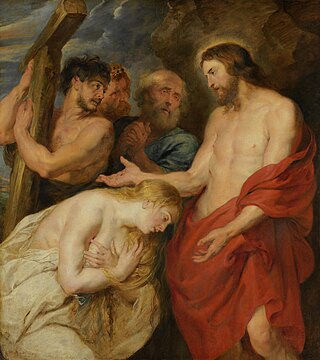
Christ and the Penitent Sinners or Christ with the four great penitents is an oil on canvas painting by Peter Paul Rubens, executed in 1617. It is now in the Alte Pinakothek in Munich.
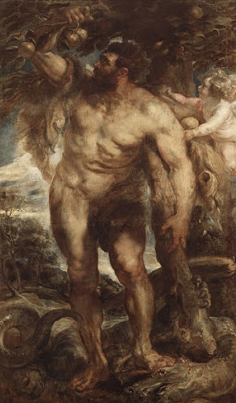
Hercules in the Garden of the Hesperides is a 1638 painting by Peter Paul Rubens. It measures 246 cm by 168.5 cm and is now in the Sabauda Gallery in Turin. It shows Hercules in the Garden of the Hesperides and forms part of a pair with the same artist's Deianira Listens to Fame.

Medusa is a c.1618 painting by the Flemish painter Peter Paul Rubens, showing the severed head of Medusa. The snakes in the painting have been attributed to Frans Snyders. Frans Snyders also helped Peter Paul Rubens with his work Prometheus Bound, where he painted the eagle portrayed in it. It is in the collection of the Kunsthistorisches Museum in Vienna. Another version is held in Moravian Gallery in Brno. Rubens was not originally attributed to the painting. Medusa was a popular iconographic symbol at the time due to the interest in Greek mythology by numerous Baroque artists such as Rubens and Caravaggio. The use of Medusa as a symbol has evolved over the course of centuries and has various interpretations of the iconographic meaning, with Rubens' painting based on an interpretation of the Greek mythological story of Medusa.

Helena Fourment with her son Frans is a c.1635 painting by Peter Paul Rubens, showing his second wife Helena Fourment holding their second son Frans. As of 2014, it is in the Alte Pinakothek in Munich.

The Resurrection of Christ is a triptych painting in oil on panel by Peter Paul Rubens, of 1611–1612, that is still in the Cathedral of Our Lady in Antwerp, Belgium. The panels were hinged, with the two wings painted on both sides, by this date a rather old-fashioned format.
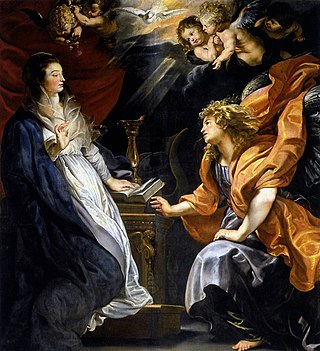
The Annunciation is the title of two paintings by Peter Paul Rubens. The first was commissioned by the Jesuit college in Antwerp and painted in 1609. It is now in the Kunsthistorisches Museum, Vienna. Around 1610 Rubens composed the second version and painted the righthand half, but then left it incomplete for an unknown reason. In 1627–1628 he completed it and also modified the figure of Mary. It is now in the Rubenshuis in Antwerp, who acquired it in 1954.

The Defeat of Sennacherib is an oil-on-panel painting by Peter Paul Rubens, now in the Alte Pinakothek in Munich, produced ca.1612–1614. It shows the defeat of the army of Sennacherib by an angel, as described in 2 Kings:19. It is a pendant to The Conversion of Saint Paul, now in the Courtauld Gallery in London.

The Adoration of the Magi is a very large oil painting by the Flemish Baroque painter Peter Paul Rubens. He first painted it in 1609 and later gave it a major reworking between 1628 and 1629 during his second trip to Spain. It is now in the Museo del Prado in Madrid.

Venus Frigida is a 1611 oil on panel painting by Peter Paul Rubens, now in the Royal Museum of Fine Arts Antwerp. It is one of the few works which he both signed and dated and derives its title from a quotation from the Roman playwright Terence, "sine Cerere et Baccho friget Venus" i.e. love cannot survive without food and wine). He draws Venus' crouched pose from what would later be called the Lely Venus, which he saw in the Gonzaga collection during his time in Mantua.

In 1635, Peter Paul Rubens created Venus and Adonis, now in the Metropolitan Museum of Art, New York. He followed the mythological story in the Metamorphoses by Ovid, inspired from his love of classical literature and earlier depictions of this scene. This oil on canvas painting shows Venus accompanied by Cupid, embracing and pulling Adonis before he goes off to hunt. The artist uses specific colors, detail and strong contrast between light and dark to depict a dramatic and emotional scene. At the time Rubens created the painting, the mythological story of Venus and Adonis was popular in Renaissance and Baroque court art. Rubens was clearly inspired by the many existing depictions of this scene, in particular the famous Titian composition of the same name, of which there are numerous versions. This depicts the same moment of Adonis leaving Venus to hunt, despite her pleas to stay. He is killed later in the day.

The Arrival of Marie de Medici at Marseilles is a Baroque painting by Sir Peter Paul Rubens executed c. 1622–1625. It was commissioned by Marie de' Medici of France to commemorate the life of her and her husband Henry IV of France. This painting was one of the 24 paintings in the Marie de' Medici cycle by Rubens. The painting is in the Louvre in Paris.




















